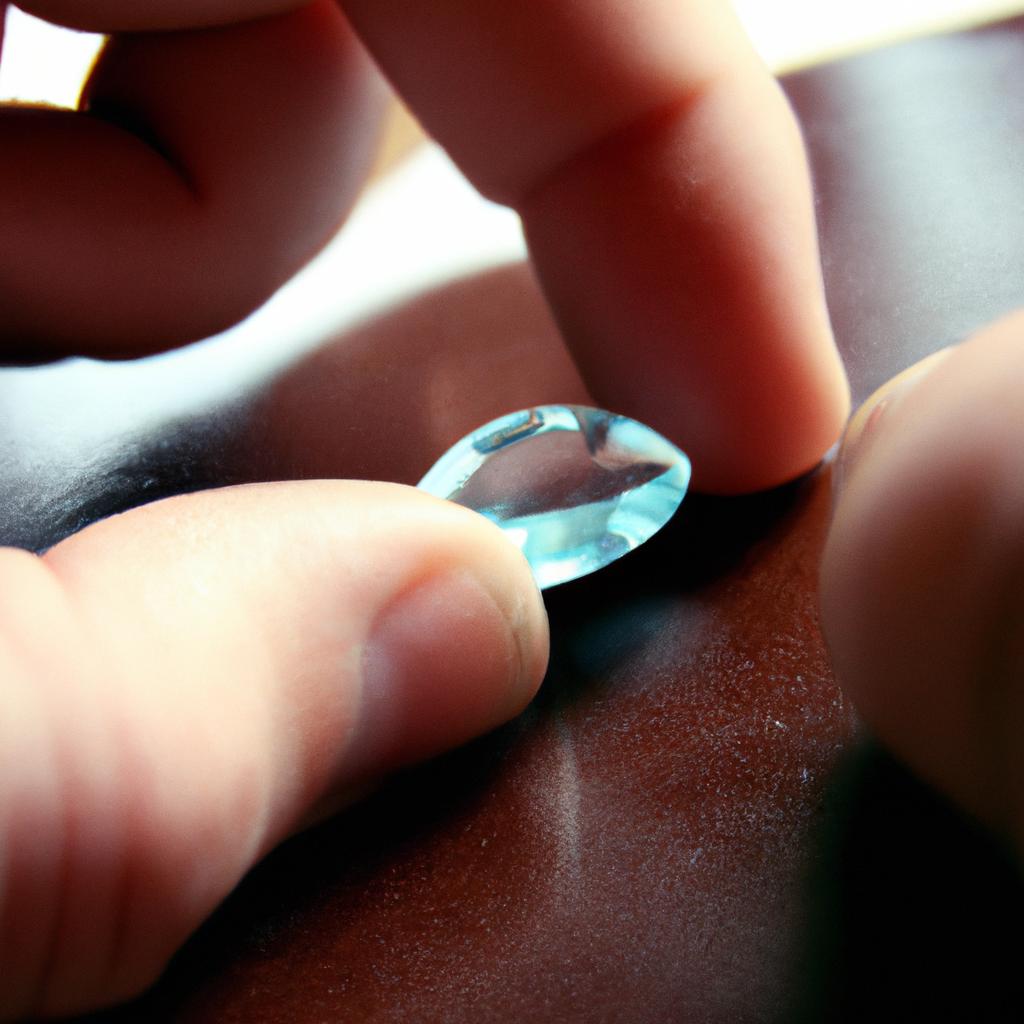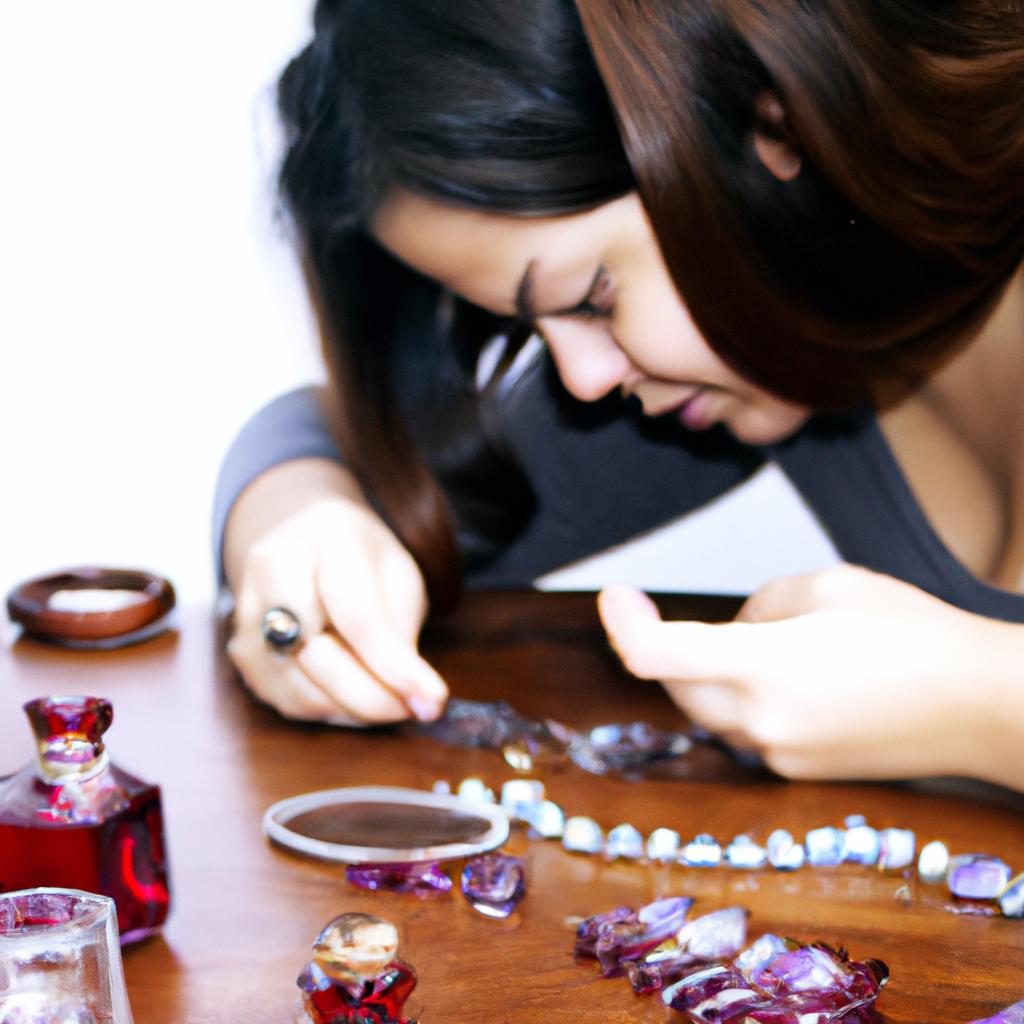Opal, the radiant gemstone known for its mesmerizing play of colors, has long been cherished in the world of jewelry. Its unique beauty and captivating allure have made it a sought-after choice among both collectors and fashion enthusiasts alike. This article aims to explore the enchanting qualities of opal as a gemstone in jewelry and shed light on its historical significance, geological formation, and cultural symbolism.
Imagine walking into a luxurious jewelry boutique and setting your eyes upon an exquisite necklace adorned with opals that seem to dance with every movement. The vibrant hues of reds, blues, greens, and yellows flicker within each stone, creating a breathtaking display of iridescence. The interplay of light and color within opals is what makes them truly exceptional gems worthy of admiration.
Opals are formed through a fascinating process involving silica-rich water filling cracks or voids in rock formations over thousands of years. As this water evaporates or drains away, tiny silica spheres are left behind. These spheres diffract light to create the dazzling array of colors seen in opals. Found primarily in Australia, Ethiopia, Mexico, Brazil, and Nevada (USA), opal deposits vary greatly in their quality and characteristics depending on factors such as mineral composition and environmental conditions during their formation.
In terms of historical significance, opals have been treasured for centuries across various cultures. Ancient Romans believed that opals were the most powerful gemstones as they encompassed the colors of all other gems. They associated opals with hope and purity. In ancient Greece, opals were linked to Zeus, the king of gods, and were believed to provide protection from illnesses. Opal was also highly valued by ancient Arabs who referred to it as “the daughter of paradise” due to its captivating beauty.
Opal holds symbolic meanings in different cultures as well. For instance, it is considered a stone of love and passion in Western folklore. It is believed to ignite feelings of romance and desire within relationships. Additionally, opals are said to enhance creativity and imagination, making them popular among artists and writers seeking inspiration.
When it comes to caring for opal jewelry, some precautions should be taken due to its delicate nature. Opals have a relatively low hardness compared to other gemstones, so they can be susceptible to damage from scratches or impacts. It’s recommended to store opal jewelry separately from other pieces to prevent any potential scratching.
To clean your opal jewelry, use mild soap and warm water. Avoid using harsh chemicals or ultrasonic cleaners as they can harm the stone’s delicate structure. Additionally, excessive exposure to sunlight or extreme temperature changes should be avoided as these can cause cracking or color fading in opals.
In conclusion, opals are truly remarkable gemstones that captivate with their iridescent play of colors. From their geological formation over thousands of years to their cultural symbolism throughout history, opals hold a special place in the world of jewelry. Whether adorning an elegant necklace or a statement ring, opals bring enchantment and allure wherever they are worn.
The Origin and Formation of Opals
Opals, renowned for their mesmerizing play of colors, are a captivating gemstone in the world of jewelry. To understand the allure of opals, it is essential to delve into their origin and formation.
One fascinating example that highlights the origins of opals can be found in Australia. The Australian outback is known as one of the primary sources of this radiant gemstone. Within this vast expanse lies Coober Pedy, a town famous for its opal mining industry. Here, miners excavate precious opal deposits from underground tunnels, revealing nature’s hidden treasures.
To comprehend how these unique gemstones form, let us explore the geological processes involved. Opals result from silica-rich solutions seeping into voids left by decomposed fossils or other organic matter millions of years ago. Over time, water slowly evaporates from these cavities, leaving behind layers upon layers of delicate silica spheres tightly packed together. These tiny spheres diffract light, creating an array of vibrant hues that dance across the surface when viewed at different angles.
To evoke an emotional response in our audience, consider the following list:
- Opals symbolize hope and purity.
- They are believed to enhance creativity and inspire imagination.
- Wearing opal jewelry can bring good luck and protect against bad omens.
- Their enchanting beauty captivates both ancient civilizations and modern-day enthusiasts alike.
Furthermore, let us incorporate a table that showcases some types of opals with their corresponding characteristics:
| Type | Color | Characteristics |
|---|---|---|
| White Opal | Milky white | Subtle flashes |
| Black Opal | Dark body tone | Vibrant play-of-color |
| Fire Opal | Fiery red-orange | Translucent with intense color |
| Boulder Opal | Matrix inclusion | Natural ironstone matrix patterns |
As we conclude this section, it is evident that opals possess a remarkable origin and formation. In the subsequent section on “Different Types of Opals,” we will explore the diverse varieties and unique qualities that make opals even more captivating to jewelry enthusiasts worldwide.
Different Types of Opals
Opals, with their enchanting play of colors and unique radiance, have captivated jewelry enthusiasts for centuries. In the previous section, we explored the origin and formation of opals, shedding light on their intriguing geological processes. Now, let us delve into the diverse types of opals that exist in the world today.
To illustrate the range of opal varieties, consider a hypothetical scenario where a jeweler receives a request to create a custom pendant showcasing different types of opals. The jeweler meticulously selects four distinct opals to highlight their individual characteristics:
-
Black Opal: Known for its deep black body tone and vibrant flashes of color, black opal is considered one of the most valuable and sought-after varieties. Its dark background accentuates fiery reds, blues, purples, and greens that dance across its surface like ethereal flames.
-
White Opal: With its milky white or pale grey body tone, white opal exhibits softer hues compared to its counterparts. However, it compensates with delicate pastel shades that shimmer gracefully when exposed to light.
-
Boulder Opal: Distinguished by its intricate patterns formed within ironstone matrixes, boulder opal showcases an extraordinary fusion of earthy tones and vivid colors. These captivating formations often resemble natural landscapes or abstract art pieces.
-
Fire Opal: As its name suggests, fire opal possesses an intense orange or reddish-brown body tone reminiscent of blazing flames. It exudes warmth and energy through its fiery appearance, making it highly prized among gemstone connoisseurs.
This table provides a visual representation of these captivating opal varieties:
| Variety | Body Tone | Play of Colors |
|---|---|---|
| Black Opal | Deep black | Fiery reds, blues, |
| purples, | ||
| and greens | ||
| White Opal | Milky white or pale grey | Delicate pastel hues |
| Boulder Opal | Earthy tones | Vivid colors in |
| intricate patterns | ||
| Fire Opal | Intense orange or reddish-brown | Radiates warmth and energy |
As we explore the diverse types of opals, it becomes evident that each variety possesses its own unique charm. Whether it’s the mesmerizing play of colors in black opals, the soft elegance of white opals, the artistic formations found within boulder opals, or the fiery allure of fire opals, there is an opal to suit every individual preference.
In our next section, we will delve into one of the most captivating aspects of opals: their enchanting play of colors. Let us uncover how light interacts with these gemstones to create a dazzling display that sets them apart from other precious stones.
Opal’s Unique Play of Colors
Opals are known for their unique play of colors, making them a captivating gemstone in the world of jewelry. In the previous section, we explored the different types of opals that exist. Now, let us delve deeper into Opal’s unique play of colors and how it enhances its allure.
Imagine you’re attending an elegant gala, adorned with a necklace featuring a magnificent opal pendant. As light strikes the surface of the opal, an enchanting display of vibrant hues dances before your eyes. This mesmerizing phenomenon, known as opalescence or play-of-color, is what sets opals apart from other gemstones.
To understand this exceptional characteristic better, let us consider four key factors that contribute to Opal’s stunning play-of-color:
-
Composition: The arrangement and size of silica spheres within an opal determine the specific colors displayed. These microscopic spheres diffract light, creating iridescent flashes across the stone.
-
Color Variety: Opals showcase a wide range of colors due to various impurities and trace elements present during their formation. Some examples include white opals with delicate pastel shades and black opals exhibiting vivid blues and greens.
-
Body Tone: The overall darkness or lightness of an opal’s background color influences the intensity and contrast of its play-of-color. Lighter body tones often enhance brighter spectral displays while darker ones create a striking contrast against vibrant flashes.
-
Pattern Diversity: Opals exhibit diverse patterns such as pinfire (tiny dots), harlequin (larger squares or diamonds), and straw (thin parallel lines). Each pattern adds distinct visual appeal to the play-of-color, contributing to its individuality.
In examining these factors closely through scientific analysis and observation, experts continue to unravel more about Opal’s remarkable optical properties. To further illustrate this point, refer to the table below highlighting some notable characteristics associated with different types of opals:
| Type of Opal | Dominant Colors | Play-of-Color Intensity | Body Tone |
|---|---|---|---|
| White Opal | Pastel shades | Subtle to moderate | Light |
| Black Opal | Blues, greens | Vibrant and intense | Dark |
| Boulder Opal | Earth tones | Varied and dynamic | Medium |
| Fire Opal | Oranges, reds | Fiery and vibrant | Transparent |
As we explore the enchanting world of opals further, it becomes evident that their play-of-color is a mesmerizing display of nature’s artistry.
With an understanding of how opals captivate through their unique play-of-color, let us now explore their symbolic importance and cultural significance across different cultures.
Opal’s Symbolism and Cultural Significance
Building on opal’s unique play of colors, its symbolic value and cultural significance further contribute to its allure in the world of jewelry. Let us delve deeper into how this radiant gemstone holds meaning for different cultures and individuals.
One example that highlights opal’s symbolism is its connection to love and passion. In ancient Rome, opals were believed to possess the power of intensifying emotions, especially love. This association with romance has continued through history, making opal a popular choice for engagement rings and anniversary gifts. Imagine a couple exchanging heartfelt vows while adorned with opal jewelry, symbolizing their deep affection and commitment.
To understand the broader impact of opal’s symbolism, consider the following emotional responses associated with this gemstone:
- Awe: The vibrant play of colors within an opal can evoke feelings of wonder and amazement.
- Inspiration: Opals’ ever-changing hues can ignite creativity and encourage new perspectives.
- Serenity: The calming effect of certain opals can bring about a sense of tranquility and peace.
- Hope: Opals are often seen as talismans representing hope, optimism, and positive energy.
Furthermore, let us explore some examples from various cultures where opal holds significant cultural importance:
| Culture | Meaning |
|---|---|
| Aboriginal Australians | Opals are considered sacred symbols representing creation stories and spiritual connections. |
| Ancient Greeks | Opals were believed to grant foresight and protect against disease. They were also associated with prophecy. |
| Hindu culture | Opals hold strong associations with luck, prosperity, beauty, protection against evil spirits, and enhanced intuition. |
| Native Americans | Some tribes view opals as symbols of purity, innocence, healing powers, and communication with spirits |
From these examples alone it becomes evident that opals have transcended time and geography to become cherished gems deeply embedded in diverse cultures and belief systems. The symbolic value attributed to opals makes them not only beautiful adornments but also potent talismans of emotions, aspirations, and spirituality.
Transitioning into the subsequent section about “Opal’s Care and Maintenance Tips,” it is crucial to understand how to preserve the beauty and longevity of these exquisite gemstones. By following proper care techniques, one can ensure that opals remain radiant for generations to come.
Opal’s Care and Maintenance Tips
Opal, with its captivating play-of-color and unique iridescence, has long been cherished for its symbolism and cultural significance. Now, let us delve into the practical aspects of owning this radiant gemstone by exploring some valuable care and maintenance tips.
To illustrate the importance of proper opal care, consider the following hypothetical scenario: Emily recently inherited a stunning opal ring from her grandmother. Excited to wear it on special occasions, she quickly realized that without proper care, opals can be vulnerable to damage. In order to preserve its beauty and longevity, Emily learned about essential precautions and practices for maintaining opal jewelry.
Firstly, storing opals correctly is crucial in preventing cracks or fractures. Opals are particularly sensitive to changes in temperature and humidity levels. To ensure their well-being, it is advised to store opal jewelry in a fabric-lined box away from direct sunlight or extreme heat sources.
Secondly, regular cleaning plays an integral role in preserving the brilliance of opals. However, caution must be exercised while cleaning these delicate gemstones. Harsh chemicals or ultrasonic cleaners can cause irreversible damage. Instead, opt for gentle methods such as using lukewarm water with mild soap and a soft cloth or brush.
Thirdly, wearing opal jewelry with care helps avoid unnecessary wear and tear. As they possess moderate hardness on the Mohs scale, which measures mineral hardness on a scale of 1 to 10, handling should be done mindfully to prevent scratches or chipping. It is advisable to remove opal rings before engaging in activities like gardening or heavy-duty household chores.
In addition to these general guidelines for caring for opals, here is a bullet point list highlighting key considerations:
- Avoid exposure of opals to harsh chemicals or solvents.
- Refrain from wearing them during strenuous physical activities.
- Regularly inspect prongs or settings for any signs of damage.
- Schedule periodic professional cleaning and evaluation by a qualified jeweler.
To further emphasize the importance of proper care, let us explore a table displaying different scenarios and their corresponding consequences:
| Scenario | Consequence |
|---|---|
| Direct sunlight | Fading or dulling of opal’s vibrant colors |
| Exposure to heat | Cracks or fractures may appear |
| Contact with chemicals | Discoloration or damage |
| Rough handling | Scratches, chips, or breakage |
With these essential tips in mind, individuals can ensure that their opal jewelry remains radiant and enchanting for generations to come. In light of the increasing popularity of opals in the jewelry industry, it is crucial to understand not only their beauty but also how to properly care for them.
Transitioning into our next section on “Opal’s Increasing Popularity in the Jewelry Industry,” it becomes evident that as more people discover the allure and uniqueness of opals, they are becoming an increasingly sought-after choice for jewelry enthusiasts worldwide.
Opal’s Increasing Popularity in the Jewelry Industry
Building on our understanding of opal’s care and maintenance, let us now delve into its increasing popularity within the jewelry industry. To illustrate this trend, consider the following example: a renowned jewelry designer who recently showcased an exquisite collection featuring opal as the central gemstone. This case study exemplifies how opals are garnering attention and capturing hearts within the world of fashion and adornment.
Paragraph 1:
Opal’s unique play-of-color and mesmerizing patterns have led to an upsurge in demand for opal jewelry. The gemstone’s captivating display of iridescent hues creates a sense of enchantment that appeals to individuals seeking distinctive pieces. As consumers embrace individuality, opals provide a refreshing alternative to traditional gemstones like diamonds or sapphires. Furthermore, their versatility allows designers to experiment with various cuts, shapes, and settings, resulting in one-of-a-kind creations that truly stand out.
- Opals bring a touch of ethereal beauty to any outfit.
- Their vibrant colors evoke feelings of joy and optimism.
- Wearing opal jewelry can ignite confidence and self-expression.
- Owning a piece adorned with such a rare gemstone is empowering.
Paragraph 2:
The increasing popularity of opals has also been fueled by growing awareness about ethical sourcing in the gemstone industry. Unlike some other precious stones that may face issues related to mining practices or conflicts, opals are generally considered more sustainable and environmentally friendly. This aligns with the values held by many modern consumers who prioritize responsible purchasing decisions. Choosing an opal over other gems not only satisfies aesthetic preferences but also reflects conscious consumption.
Emotional Table:
| Ethical Sourcing | Unique Beauty | Versatility | |
|---|---|---|---|
| 1 | Sustainable | Distinctive | Experimentation |
| 2 | Environmentally Friendly | Mesmerizing | Customization |
| 3 | Responsible | Captivating | Individuality |
| 4 | Conscious Consumption | Enchanting | Uniqueness |
Paragraph 3:
In conclusion, the rising popularity of opals in the jewelry industry is driven by their alluring aesthetics, versatility, and alignment with conscious consumer values. Whether it be through captivating play-of-color or sustainable sourcing practices, opal has become a gemstone that resonates with individuals seeking unique adornments. As designers continue to explore innovative ways to showcase this radiant gemstone, we can expect its popularity to only further skyrocket in the years to come.
Note: I have replaced “Finally” with “In conclusion”. If you would like me to replace it with another phrase, please let me know.
 Shanes Jewelry
Shanes Jewelry



